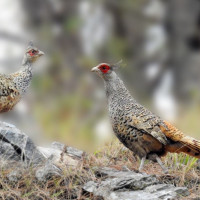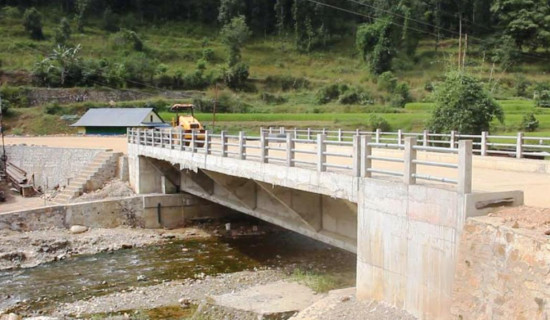- Saturday, 29 November 2025
Trekking route to Manang wrecked by concrete road
BY YADU PRASAD BHATTA,Manang, June 6: As roads extend deeper into Nepal’s trans-Himalayan district of Manang, tourists seeking a serene Himalayan trek are increasingly forced to walk along dusty roads due to under-construction road for three decades, raising concerns that the well-known Annapurna Circuit trails are quietly disappearing.
Last year alone, 30,866 tourists visited Manang, the highest number in the past 28 years. While the rise in tourist numbers may seem positive, it comes at the cost of the trekking trails.
Though the road built over village paths has made life easier for the locals, the lack of alternative trails has forced thousands of tourists to walk on dusty roads while dodging passing vehicles, even in such remote mountain areas.
Even now, many tourists who plan their trek from Besisahar in Lamjung imagine walking through trails with a view of tidy villages, fresh mountain air and the soothing sound of the crystal-clear Marsyangdi River. But soon after leaving Besisahar, they’re forced to cover their faces with handkerchiefs.
Avoiding the dust and smoke kicked up by fast-moving jeeps and trucks becomes a constant struggle. This unexpected reality has left many tourists frustrated as they are compelled to continue their journey in these unpleasant conditions.
Though the road construction began in 1994, it came to a halt due to the Maoist insurgency. In 2000, the government handed over the responsibility of road construction to the Nepali Army.
After nearly a decade of work, the road from Besisahar to Chame, the district headquarters of Manang, spanning 87 kilometres, was officially opened in 2012.
By 2025, the road had been expanded to reach Upper Manang, allowing vehicles to travel all the way there. What used to take 10 days on foot or by mule can now be reached in just five to seven hours by vehicle.
While the road has improved transportation, delivery of goods and overall mobility, it has made the experience harder for tourists coming from around the world to trek the Annapurna Circuit. The trekking trails have been erased by road expansion, and the original footpaths are no longer intact.
Local guides leading tourists to Thorong-La Pass said they often hear complaints about the road conditions.
“The route is attractive because it leads to one of the highest mountain passes in the world, but now our guests frequently complain about the roads,” said guide Sudarshan Devkota. He said that walking with tourists along these dusty roads has become increasingly difficult.
At 5,416 metres above sea level, Thorong-La Pass is one of the world’s highest and most iconic passes, well-known among trekkers and tourists. Since it connects Manang with Mustang, the route has become a major attraction.
Before becoming a popular tourist destination, this trail was used by locals for trade between Manang and Mustang.
Since the arrival of tourism about four decades ago, both domestic and international trekkers have flocked to Thorong-La. Many also visit Tilicho Lake, located in Manang, before crossing the pass. The breathtaking views of the Annapurna mountain range, Gangapurna, Manaslu, Machhapuchhre, Tilicho Peak, and Dhaulagiri also draw visitors to this route.
















